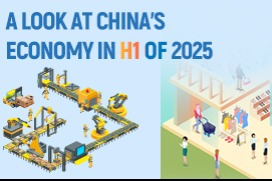Catch-up potential, digital tech vital for growth


China's growth potential, ongoing as well as in the foreseeable future, depends on two vital factors. First, its ability to play catch up with major economies and next, upon new possibilities unleashed by digital technology through a fresh tech revolution and green transition.
Two potentials
The catch-up potential refers to the nation's efforts to keep abreast with what developed economies have accomplished so far, one that China still has room to achieve.
For example, the country's current per capita income is around $13,000, and its target is to reach the per capita income level of moderately developed countries by 2035. This represents an additional potential growth of about $20,000 in per capita income.
To fill the gap, China will primarily rely on the growth of its services sectors, driven by an upgrade to its consumption structures and traditional industries such as manufacturing and agriculture. It is more realistic and feasible for China to focus on achieving its catch-up potential.
However, from a perspective of new potential derived from digital technology and green transformation, the gap between China and its developed counterparts is not that big. In certain areas, China is keeping pace or even leading the race.
It is essential to note that the two potentials are not separate but intertwined. This constitutes a significant advantage for China. Its vast market size and relatively lower income levels provide ample room for growth. Economies of scale can help the country lower costs quickly, while new technologies and industries can help it gain a competitive edge in a relatively short period, as evidenced by China's recent development in areas such as the internet, mobile communication and new energy vehicles.
Balance is key
Of late, there have been increasing calls to loosen macroeconomic policies following insufficient demand and weakening growth momentum. This year's government work report has emphasized the need to intensify macroeconomic regulation while coordinating the expansion of domestic demand with deepening supply-side structural reforms.
Regarding the effect of macroeconomic policies on the economy, it is crucial to recognize the significant differences between China and developed economies, which are in a mature stage of development featuring slow growth. They generally lack new growth drivers. Therefore, macroeconomic policies can, to a large extent, determine their overall economic growth trends.
But China still holds potential to grow by at least 5 percent, and has yet to enter a phase of slow growth. Since China is still in a medium growth phase, its macroeconomic policies primarily play a stabilizing role and cannot have as big an impact on growth as in developed countries.
It is estimated that the impact of macroeconomic policies on GDP growth stands at about one percentage point in China, while the remaining four percentage points come from technological conditions and the policy environment. The 1:4 ratio aptly answers the question of which factor — macroeconomic policy or structural reform — is more important.
In this sense, as China pursues stable growth, it is essential for policymakers to properly handle macroeconomic policies, making them appropriately loose and proactive. However, we should not focus solely on macroeconomic policies without paying adequate attention to the promotion of structural reforms.
Role of spending
The most basic way of expanding domestic demand is to increase incomes. As China approaches the threshold of a high-income country, international experiences show that the proportion of consumption or worker wage income to the entire economy will rise significantly.
To begin with, we need to differentiate between two types of consumption: survival-oriented consumption and developmental consumption.
Survival-oriented consumption, primarily focused on basic daily needs such as food and clothing, has largely stabilized in the country due to its economic development. Therefore, the current growth in consumption is predominantly driven by developmental consumption, which includes consumption related to social security, healthcare, education, sports and entertainment, financial services, transportation and communication.
These two types of consumption are hugely different.
Survival-based consumption is primarily individual-based, while developmental consumption is closely tied to government public services. A substantial portion of the latter is supported by government expenditure on basic public services, which makes it, in essence, a combination of government and household consumption. Currently, there are considerable gaps in developmental consumption, with the need to address unmet basic public services for nearly 300 million migrant workers in cities, being a major one.
In short, the current focus on expanding consumption should address two key issues. First, it is general developmental consumption based on basic public services, and second, the access of middle- and low-income groups, mainly rural migrant workers, to basic public services.
Three equalities
From the demand-side perspective, promoting structural reforms essentially boils down to the issue of urban-rural relations. The "three equalities" — equal identity, equal rights to access basic public services, and equal property rights regarding land and real estate — should be advocated in the development of rural-urban integration.
Equal identity pertains to the reform of the household registration, or hukou, system. In this regard, the household registration policy should be loosened and the separate treatment arising from a difference in urban-rural resident identity be eliminated, excepting a few areas with special needs and conditions.
Regarding equal rights to access basic public services, a new action plan focusing on the housing needs of the nearly 300 million rural migrant workers in cities should be mapped out and implemented; the government can acquire some commercial apartments and convert them into public housing for these workers.
The unequal distribution of land rights, meanwhile, contributes significantly to low rural incomes. Urban residents can freely trade their commercial housing, while sales of rural buildings, which are built on collective land, face many restrictions.
The low rural incomes stem primarily from the restriction on property rights, especially that on the transfer or trade of land.
The 3rd plenary session of the 18th Central Committee of the Chinese Communist Party, held in late 2013, touched on the issue of rural land system reform. But in reality, progress in this respect has been very slow. My suggestion is that the authorities should consider allowing rural collective construction land in urban-rural fringe areas to enter the market for transactions at the same price as State-owned land.
Embracing entrepreneurship
China is facing many challenges, such as overcoming the middle-income trap, fostering new quality productive forces, and promoting high technologies; and resolving those challenges requires entrepreneurial spirit.
First, we should differentiate between entrepreneurs and capitalists. Entrepreneurs possess qualities such as curiosity, foresight, insight, adventurous exploration, resilience, organizational coordination and execution, which are even scarcer than the combination of resources, including capital, labor, land and technology.
A capitalist, on the other hand, refers to a provider of capital. Since the reform and opening-up policy was initiated more than 40 years ago, the development of the private sector in China has largely been driven by a large group of private business owners, known as entrepreneurs, who possess the above-mentioned qualities.
Moreover, Chinese enterprises used to be categorized by ownership, but nowadays, enterprises with diversified ownership have become normal, and purely State-owned enterprises are fewer. Such a categorization is no longer in alignment with corporate and market realities and, more importantly, it undervalues the entrepreneurship of business owners, because entrepreneurship is the most important factor behind the performance of an enterprise.
Therefore, we should readjust the classification of enterprises based on their size, technology and employment, among others, and formulate corresponding policies.
This is not to say that ownership is no longer relevant, but rather that it is the investing entities that should be categorized based on ownership. For instance, enterprises can be categorized as central State-owned, local State-owned, institutional, individual, or foreign-invested, among others, and all enterprises should be treated equally despite their ownership.
Solid headway should be made in rectifying ownership discrimination, and platform enterprises and large technology companies, for example, should be encouraged to invest and actively engage in innovation activities.
Liu Shijin is deputy director of the Committee on Economic Affairs of the 13th National Committee of the Chinese People's Political Consultative Conference, and vice-chairman of the China Development Research Foundation.
The views don't necessarily reflect those of China Daily.




































